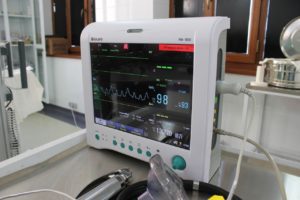The United States is turning green. And it has been for a while. State legislators have been passing laws over the last three decades that allow the medical use of marijuana.
Medical marijuana is being approved at the state level to alleviate a wide variety of adverse health symptoms. Common qualifying conditions for a medical cannabis card include chronic pain, wasting syndrome, or even PTSD. Qualifying conditions vary greatly from state to state and we’ll be covering each one in greater detail in future articles.
This article covers the state of the nation when it comes to the legalization of medical marijuana. Wondering where your state stands on marijuana and whether you can get a medical cannabis card where you live? Find out below.
Which States Can You Get a Medical Cannabis Card From?
Medical cannabis has been legalized in most states in the US. So, to answer the question of which states allow medical cannabis cards, it might be simpler to list those states that do not currently allow it.
Medical Cannabis Cards are Not Allowed in These States (Yet)
Only ten states in the United States currently do not have laws legalizing medical marijuana. Of these, multiple states are in the process of passing legislation that will legalize medical cards for cannabis in the near future. So, as of January 2023, the only states you cannot get a medical cannabis card are the following:
- Indiana
- Kansas
- Kentucky
- Mississippi
- Nebraska
- North Carolina
- South Carolina
- Tennessee
- Wisconsin
- Wyoming
Medical Cannabis Cards are Allowed in These States
So, where can you get a medical cannabis card? Below is the lengthy list of states where you can currently get a medical cannabis card as a resident living in that state.
- Alabama (2021)
- Alaska (1999)
- Arizona (2010)
- Arkansas (2016)
- California (1996)
- Colorado (2001)
- Connecticut (2012)
- Delaware (2011)
- District of Columbia (2010)
- Florida (2017)
- Georgia* (2019)
- Hawaii (2000)
- Idaho (2017)
- Illinois (2014)
- Iowa* (2017)
- Louisiana (2016)
- Maine (1999)
- Maryland (2014)
- Massachusetts (2013)
- Michigan (2008)
- Minnesota (2014)
- Missouri (2018)
- Montana (2004)
- Nevada (2001)
- New Hampshire (2013)
- New Jersey (2010)
- New Mexico (2007)
- New York (2014)
- North Dakota (2016)
- Ohio (2016)
- Oklahoma (2018)
- Oregon (1998)
- Pennsylvania (2016)
- Rhode Island (2006)
- South Dakota (2021)
- Texas (2015)
- Utah (2022)
- Vermont (2004)
- Virginia (2015)
- Washington (1998)
- West Virginia (2019)
How Long Has Medical Marijuana Been Legal?
It all started back in 1996. California was the first state in the nation to legalize marijuana for medical treatment. Within two years, Oregon and Washington state followed suit, joining California as the first group of states in the nation to allow medical cannabis use. Maine and Alaska joined in 1999, just before the turn of the century.
Over the next decade (2000 to 2010), nearly a dozen more states added legislation to allow medical cannabis cards, including Michigan, Rhode Island, and Nevada, along with several others. By the time that states began legalizing recreational marijuana, over a third of the country’s states had legalized medical cannabis.
From 2012 to 2022, that number grew exponentially, adding another 24 states to the list of states where you can get a medical card for cannabis. The most recent states to pass legislation approving medical marijuana include Utah, Alabama, and South Dakota within the past two years.
A few states are still working today to pass legislation to legalize medical cannabis.
How Long Has Recreational Marijuana Been Legal?
States began allowing recreational marijuana in 2012, with Washington state and Colorado being first. Today, nearly 20 states have legalized recreational marijuana, with three more states pending.
Below are the states that have legalized marijuana for recreational use (or have pending laws allowing it).
- Alaska (2015)
- Arizona (2021)
- California (2016)
- Colorado (2014)
- Connecticut (pending)
- District of Columbia (2015)
- Illinois (2020)
- Maine (2017)
- Massachusetts (2016)
- Michigan (2020)
- Missouri (pending)
- Montana (2021)
- Nebraska (pending)
- Nevada (2017)
- New Jersey (2021)
- New Mexico (2021)
- New York (2021)
- Oregon (2016)
- Rhode Island (2022)
- Vermont (2018)
- Virginia (2021)
- Washington (2012)
Getting a Medical Cannabis Card Vs. Buying Recreational
If you live in a state that allows both medical marijuana cards and recreational use, you may be wondering—why would you still get a medical cannabis card?
Here are a few reasons that people choose to get a medical cannabis card rather than depending on recreational use alone:
- Tax benefits: Medical marijuana is often taxed less than recreational marijuana.
- Legal protections: Medical marijuana laws generally provide more protections from discrimination (employers, housing, etc.) than recreational use laws.
- Allowances: Medical marijuana laws often permit higher possession quantities and potencies than recreational use laws.
Since medical cannabis is being legalized at the state level (rather than the national level), the process to get your cannabis medical card will look different depending on where you live. Let us help you navigate your state’s requirements.
Apply for Your Medical Cannabis Card Today
If your state is on the list above for allowing marijuana medical cards—and you have a qualifying condition—My Virtual Physician can help. We can provide physician certifications to patients for their state’s medical cannabis card applications. Get started now!
*These states have limited legalization and may only include THC oils for medical use.
Women who have dedicated their lives to medicine may have an unsettling common denominator. Infertility in women is on the rise.
According to the American Medical Women’s Association, studies show that one in four female doctors struggle with infertility—that’s a whopping 25%.
Infertility is a growing problem. In the general population of the US, 19% of couples spend more than a year trying to get pregnant. For female doctors trying to start their families, the problem seems to be exacerbated.
Fertility Basics and At-Home Testing
If you’re a physician interested in learning more about your own fertility, we have resources for you. Learn more about fertility in our four-part blog series on testing for fertility indicators. For women working in higher-risk careers, it’s important to be proactive about fertility.
- Curious about your fertility?
- How can I test my fertility at home?
- How do I read my fertility results?
- What do I do if my fertility test comes back abnormal?
Why Women in Medicine Face Infertility at a Higher Rate

The exact reason that women in medicine face higher infertility rates is not clear. It’s likely a combination of factors. Below, we’ll outline a few likely culprits.
Delayed Family Planning
With each menstrual cycle that passes, the chance of getting pregnant decreases. A woman under the age of thirty has a 25-30% chance of pregnancy for each cycle. By a woman’s 40s, her chances of getting pregnant are reduced to 10% per cycle.
It’s well-known that age plays a role in women's fertility. It’s also common knowledge that it takes several years of education, training, and focus to become a doctor. Many women in medicine choose to delay starting a family during the years before becoming licensed to practice. The average age of a woman giving birth is 27, but for women physicians—it jumps up to 32 years old.
Medical school and residency often take up a dozen or so of a woman’s precious child-bearing years. By the time a woman reaches physician status, she’s likely already in her thirties and her ovarian reserve begins diminishing. We encourage women in medicine to see a fertility specialist. This is especially important for women over 30 who are trying for a baby.
It’s simple to see how it happens. Settling down to start a family often gets put on the back burner while your career launches, and before you know it, you’re nearing forty and still without a child. All this time, you may not have considered that your fertility may be compromised.
Related: Infertility: When is it Time to See a Doctor?
Lifestyle
Who has time to settle down and find a mate when you’re busy trying to get trained on how to become a doctor? Busy schedules are another common reason that female doctors aren’t having babies as much as their non-physician counterparts. By the time you get back into the dating scene, your fertility has likely already peaked.
Other lifestyle factors that may play a role might include working in high-stress environments (although the relationship between stress and infertility is not well-understood), poor diet, lack of exercise, alcoholism, and more. The answer to the exact cause of the correlation between female physicians and infertility is still being studied.
What Can Female Physicians Do to Promote Fertility Health?
Recognizing that there is a relationship between career choice and infertility is the first step to being proactive. Women in medicine must be informed that they are embarking on a career choice that could put them at a higher risk of infertility.
Even though women in medicine struggle more than others with infertility, there are proactive steps that can be taken to combat infertility in women.
Below are a few steps you can consider taking now:
- Test your fertility: Learn how to test your fertility from home.
- Naturally boost your fertility: Check out this article for some steps you can take today to naturally boost your fertility.
- Conceive earlier: Avoid putting off starting your family and conceive while still in training.
- Consult with a fertility specialist: Early intervention can increase your chances of conceiving.
- Consider cryopreservation: Freeze your eggs for when you’re ready.
If you’re currently struggling to conceive, our online OBGYNs can help with treating infertility.
How an Online OBGYN Can Help
If you’re a female physician who is concerned about this trend of women's infertility in the profession, My Virtual Physician is in your corner. We’re here to consult with you and provide answers. We can assist with regular fertility testing and our online OBGYNs serve patients in all 50 states.
If you’ve already received a concerning fertility test result, we’re available to consult with you on the best plan of action to move your fertility forward. Online appointments are available now; book your appointment today to meet with our board-certified OBGYNs.
Book Appointment Now Call For An Appointment
 Everyone needs to see a doctor at some point in their lives. Whether you’re facing an illness, pain, disorder, or just need a medication refill or regular checkup; our society relies heavily upon primary care physicians.
Everyone needs to see a doctor at some point in their lives. Whether you’re facing an illness, pain, disorder, or just need a medication refill or regular checkup; our society relies heavily upon primary care physicians.
How long has it been since you last saw yours?
The Problem
It can be a struggle to get an appointment scheduled with your Las Vegas primary care physician (PCP). Waits are long and many doctors aren’t even accepting new patients. One reason for this is that there is a shortage of physicians.
Related: Increasing Access in Las Vegas: Physician-to-Patient Ratio
That may leave you wondering—what can I do to see a Las Vegas doctor sooner? Read on to find out a solution to the doctor access dilemma.
Availability isn’t the only problem that patients face when trying to schedule doctor appointments in Las Vegas. Physical limitations, such as transportation, access to technology, and geographical location, can also hinder access for patients to see their doctors regularly.
What’s a PCP and Who Needs One?
A primary care physician, or PCP for short, is a general practitioner who you know as your “go-to” doctor. Any time you have an infection, need medication, or want a consultation, your PCP is probably your initial point of contact.
This type of doctor sees a broad range of patients, in the age ranges of anywhere from children to the elderly, and treats a wide variety of conditions. If you have to manage an ongoing health condition, such as diabetes or asthma, you likely see your PCP more frequently.
While it’s not necessarily required to have a PCP, establishing a relationship with a primary care doctor in Las Vegas can be beneficial for both patients and physicians. That’s because your doctor can get to know you, your health, and you become comfortable with one another to discuss private health matters.
Reasons to See Your Primary Care Physician (PCP)
Here’s a list of common conditions or patient needs that most primary care physicians are capable of handling without the need for specialist visits:
- Diabetes
- High blood pressure
- Dietary
- Acid Reflux
- Birth control
- Urinary tract infections
- Minor skin infections
- Preventative exams and physicals
- Allergies
- Ear aches
- Sinus infections
- Cough and cold
- Skin rashes
- STD testing and treatment
- Mental health
- Digestive problems
- Vaccines
But if you can’t get in to see your PCP or get established with a new primary care doctor in Las Vegas, then what can you do?
A Simple Solution
My Virtual Physician has a new solution to the patient access problem in Las Vegas. Our Las Vegas specialists can provide PCP services online through our hybrid clinic on Paradise Road.
Related: Hybrid Medical Clinics: Expanding OBGYN Access in Las Vegas
This physical clinic solves many problems when it comes to patient access to doctors in Las Vegas.
Can’t get an appointment? No problem, walk-in visits are welcome in our hybrid clinic.
No computer, phone, or internet connection? Our hybrid clinic offers a private room with all the technology already set up for our patients to use.
Need a second opinion? Our professional doctors are available to meet with you today to provide medical advice.
Uninsured? My Virtual Physician offers affordable and transparent pricing on our telemedicine appointments, both in the clinic and online.
See a Doctor in Las Vegas Today
Stop waiting for an opening at your traditional doctor’s office. See a doctor today in Las Vegas who can meet your healthcare needs.
Book Appointment Now Call For An Appointment
Visiting the doctor can be a frightening experience for children. Even for parents, these appointments can be uncomfortable, time-consuming, and even heartbreaking. Luckily, telehealth is making pediatric check-ups a little less scary.
In this blog, you’ll find out when and how you can conveniently see an online pediatrician—without the tears. As a bonus, if you’re in the Las Vegas area, there’s an alternative way for your child to see a pediatrician virtually inside our walk-in clinic on Paradise Road.
Let’s start with how telemedicine can be a lifesaver when your child is ill.
Getting Care When Your Child is Sick
When your child is sick, all you want is for them to feel better again. Whether your son or daughter is an infant or a teenager, sometimes you need to seek outside help from a pediatrician to see if medication or other treatments are needed to get better.
How Do I Know if My Child Needs Urgent Care or Emergency Care?
It’s difficult to watch your child as their little body struggles to fight off an illness. It’s every parent’s worry whether they are doing enough to get their child back to feeling better. This can be especially distressing with newborns, infants, toddlers, and children with special needs who can’t verbally articulate their complaints.
If your child has a troubling cough, spikes a high fever, or has experienced a sprain, cut, or another seemingly minor injury that isn’t going away—you may be wondering whether your child needs more critical medical assistance, such as “convenient-care” or a visit to the ER. It can be a tough call, and an expensive one. If you need help making that decision, our online pediatrician and virtual doctors can help.
What Can an Online Pediatrician Help With?
Consulting with an online Las Vegas pediatrician can save you time, money, and worry. From the comfort of your own home and for an affordable flat fee, you can set up a virtual visit for your child to be seen by a doctor who can immediately:
- Observe and diagnose
- Prescribe medications or treatment
- Make recommendations to escalate care to the ER or an in-person clinic
- Ease your concerns and give care advice to help you comfort your child
Related: The RSV Virus is Spreading in Las Vegas: Should You be Concerned?
Conditions That Can Be Treated by an Online Pediatrician
Some conditions won’t get better on their own and may require medical intervention and prescriptions. For example, if your child has symptoms of pink eye (conjunctivitis), it may require prescription medication. A doctor can prescribe medications to help clear infections caused by bacteria.
Online pediatricians can treat a range of conditions virtually, including:
- Skin rashes
- Acne
- Coughing
- Cold symptoms
- Flu symptoms
- Stomach issues
- Minor injuries
- Pink eye
The biggest advantage to visiting virtually with your child’s pediatrician is that it can be done from home. Stay home with your child while still receiving professional care and medical advice from a doctor. You can rest easy knowing that you’ve done everything in your power to nurture your child back to health.
Can My Child Routinely See a Pediatrician Online?
Yes, your child can see a pediatrician online for routine visits. Don’t wait until your child is sick to try out a virtual pediatric visit. Children can visit online pediatricians for things like preventive care, routine wellness check-ups, and follow-ups.
Parents can also set up virtual appointments for their child when they want a doctor’s professional advice on things such as their child’s nutrition, behavior, and social and emotional development. In these cases, you can set up online consultations directly with your child’s pediatrician. It has never been more pain-free to see a pediatrician in Las Vegas..or anywhere!
Getting a visit in today with a friendly and compassionate pediatrician who supports telemedicine capabilities—like My Virtual Physician’s Dr. Ayyagari—can help your child feel more comfortable during a sick visit when they aren’t feeling so well.
Alternatively, you can mix virtual care with in-person care for your child. See your local brick-and-mortar pediatrician for milestone visits and vaccinations, and depend on your online pediatrician for more immediate concerns, sick visits, or to gain a second opinion when necessary.
How Can I Get My Child in to See the Doctor ASAP in Las Vegas
The quickest way to get your child in to see a pediatrician is through a walk-in clinic or online visit.
In 2022, My Virtual Physician opened a new kind of clinic on Paradise Road in Las Vegas—a hybrid clinic. Here, you can physically walk into our brick-and-mortar location for an immediate televisit with a specialist.
You can bring your child into the clinic, have their vital signs measured by our certified medical assistant, and then meet virtually with our pediatrician in a private room where all of the equipment is set up for the telemedicine visit.
Related: Hybrid Medical Clinics: Expanding OBGYN Access in Las Vegas
You can also schedule appointments ahead of time for vaccinations and other care needs that can be met inside our hybrid clinic by a Las Vegas doctor. Our hybrid clinics provide increased access for children and adults alike to see their doctors, without needing any special equipment or internet service.
Get Established Today
Forget the anxiety, frustration, and tears that traditional pediatric doctor’s appointments bring. Get established today with our online pediatrician, who can help walk you through your child’s development and medical needs.
Book Appointment Now Call For An Appointment
Schedule a virtual appointment to get your child seen by our pediatrician, or walk in with your little one to our clinic on Paradise road to see a Las Vegas doctor today.
Need to see a specialist? Whether you’re looking for a Las Vegas OBGYN or a pediatrician for your child, getting established with a specialist physician can be an intimidating venture.
It used to be a lengthy, expensive, and convoluted process.
Luckily—things have changed. Today, there’s a new path available for patients. Now, you can see a healthcare specialist without the red tape.
More providers are paying attention to the patient experience, and a clear demand has surfaced: patients need easier access to specialists for healthcare. Healthcare specialist appointments must be easily accessible, swiftly scheduled, and transparently priced.
In this blog, we’ll define what specialists are and when you need to see them. And then, we’ll explore the processes required to see a healthcare specialist, both old and new—letting you in on the secret to seeing a Las Vegas Specialist in a snap.
What is a Specialist?
When you call to schedule your appointment for your annual physical or a routine checkup, you’re likely booking with your primary care physician. These doctors can handle a wide range of common medical ailments seen in the general population.
A specialist, on the other hand, is a doctor who has expertise in a particular body system.
For example, an OBGYN specializes in the female reproductive system. Read more about the special care focus of an OBGYN below in the related blog at the link below.
Related: What’s an OBGYN: Get to Know Our Las Vegas Gynecology Team
An ENT doctor specializes in ailments of the ears, nose, and throat. A pediatrician specializes in the healthcare needs of children.
Here are some other specialists found in our healthcare system:
- Endocrinologists: experts in hormones and metabolism
- Cardiologists: experts in the circulatory system and heart
- Dermatologists: experts in skin diseases
- Gastroenterologists: specialize in the digestive system
- Internists: specializes in functioning of the internal organs
This is just a small selection of the many specialty fields out there in the world of healthcare.

When Should I See a Specialist?
There are many reasons to seek medical care from a healthcare specialist. Here are a few.
Your Primary Care Doctor is Unable to Treat Your Condition
If you’re experiencing a chronic medical condition that your primary care doctor is unable to treat, it may be time to see a specialist. For example, if you’ve been asking your regular doctor to help clear up a skin condition, but it doesn’t seem to be improving—a dermatologist, who specializes in skin conditions, may be more qualified to help. Sometimes your doctor will refer you to a specialist; other times, you may need to seek out the specialist yourself.
You Have a Rare (or system-specific) Condition
Primary care physicians (PCPs) are trained to treat a broad scope of conditions that occur in the general population. If you know that you have a condition that is rare or that a specialist is more qualified to treat, then it may be appropriate to book directly with a specialist rather than a PCP. For example, if you have irregular menstrual cycles, an OBGYN or endocrinologist may be better able to pinpoint a care plan than a doctor with general training.
Your Regular Doctor is Unfamiliar with Treatments
A third reason that patients desire to see a specialist is to find a doctor who is more familiar with treatment options that they have researched. If a primary care doctor is unfamiliar with a treatment that you want to try, seeing a specialist with experience using the treatment is a valid option.
So, now that you know when it’s time to see a specialist—let’s look at how to do it.
The Traditional Method
First, the long way.
Traditionally, the process of seeing a specialist involved making multiple appointments. Ultimately, your primary care physician was the gatekeeper who decided whether patients were permitted to schedule an appointment with a specialist.
Sometimes, you’d also need to have pre-approval from your insurance company before seeing a specialist. Insurance companies may deny coverage of specialist visits if the proper referral paperwork is not filed by your doctor’s office.
With the traditional method, you had to jump through hoops to see a specialist physician, including:
- Multiple appointments required
- Pre-approval is required for insurance coverage
- Primary care physicians must provide a referral
- Long waiting list to get an appointment
With the shortage of specialists in the Las Vegas area, seeing an OBGYN or other specialists in the area could take months.
Luckily, there’s a better way!
Bypass the Wait and See a Specialist Today
It’s hard to believe that anyone would follow the long process above to see a healthcare specialist when there’s such a simple shortcut. So, how can you see a specialist physician without jumping through hoops?
Schedule directly with your specialist.
My Virtual Physician wants patients to have access to specialists. That’s why we are here. Our patients have the option to visit with our Las Vegas specialists either online or inside our hybrid clinic located on Paradise Road in Las Vegas.
Our specialists include:
- Obstetricians and Gynecologists (OBGYNs)
- Internist
- Family medicine
- Chronic care physician
- Pediatricians
My Virtual physician offers transparent pricing and affordable visits for self-paying patients. Read more about grabbing affordable medications as a self-pay patient below.
Related: Guide to Self-Pay Prescriptions: Get the Best Price on Medications
If you’re located or visiting the Las Vegas area, walk-ins are welcome at our hybrid clinic. At this clinic, you can visit virtually with our specialists inside a private exam room right on the Vegas strip, making seeing a specialist on your own terms as easy as can be.
Ready to Schedule Your Specialist Appointment?
If you’re ready to book your appointment with one of our specialists, click below to self-schedule or walk into our hybrid clinic for an instant appointment. We look forward to serving you by providing a positive patient experience.
Book Appointment Now Call For An Appointment
You’ve been planning this vacation for months and now you’ve arrived—you finally made it to Vegas! Now, the fun begins…
You’re full of excitement and ready to experience the Vegas strip and have some fun! But there’s one detail that you probably didn’t plan out while you were booking tickets, packing your bags, and making your way to Nevada.
That detail is this—what to do if you need to see a doctor while you’re on vacation.
If you’re insured, seeing an out-of-state doctor may mean that you’ll face steep out-of-network charges that don’t count toward your regular deductible. If you’re uninsured, you might get stuck with hefty out-of-state medical bills.
If you’ve just arrived at your hotel in Las Vegas and realized you need to see a doctor ASAP, here’s what to do in order to see a doctor quickly and affordably so that you can turn your focus back to enjoying your vacation.
Step #1: Write Down Your Troubles
Before making any decisions, just pause for a moment. Focus on the reason that you need to see the doctor. If it’s because you forgot your medications at home, then write down the medications that you need refilled in Las Vegas to cover you during your vacation.
On the other hand, if you’re having indications of an illness that requires medication for you to feel better, write down your symptoms and how long you’ve had them. Some common illnesses that pop up during vacation include UTIs and bacterial infections.
If you feel a urinary tract infection (UTI) coming on or you are experiencing a sudden and extreme sore throat, write down your answers to the following questions:
- What are your symptoms?
- When did your symptoms begin?
- What is your pain level?
- What triggers or changes your pain level?
- Are your symptoms getting worse?
In many cases, you’ll continue to feel miserable until you get antibiotics to fight the infection if it’s caused by bacteria. Tracking your symptoms as soon as you notice them can help you evaluate whether things are getting worse.
Related: What To Do If You Are Traveling With a UTI on Your Road Trip to Las Vegas
Take an account of the facts and assess the urgency of your situation before reacting. Once you’ve got your troubles documented, you can make an informed decision on whether or not you need to see a doctor.
Step #2: Determine the Type of Doctor You Need to See
The next step before taking action is to figure out the best type of doctor that can help you. A general practitioner can handle many common health concerns. But local doctors probably won’t have an opening for months and an urgent-care clinic staffed with general practitioners might cost you a small fortune in medical bills.
If your medical need requires a specialist, how can you find one in Vegas? Specifically, can you find an OBGYN in Las Vegas? OBGYNs specialize in the female reproductive system and cover anything from contraceptive prescriptions to menstrual problems and infertility. Read more about what conditions OBGYNs treat.
Once you’ve narrowed down whether it’s a general practitioner or a specialist that you need to see, you can start looking for a doctor or clinic. The two main places to look are in-person clinics in Las Vegas or online.
Step #3: Check Telehealth Options or Find a Local Walk-in Clinic
Telemedicine has provided greater access to healthcare and specifically, to specialists. Today, you can see a doctor in minutes rather than months. Searching for a provider online (who is licensed to practice in Nevada) can be one of the simplest solutions to finding a provider while traveling.
Online providers also tend to be more self-pay friendly. Since insurance companies don’t typically cover out-of-network providers, going online can be an affordable alternative. You’ll find a wide selection of specialists online who are taking new appointments.
Related: What to Expect During an online OBGYN Las Vegas Appointment
If you prefer a brick and mortar visit to the doctor without breaking the bank, My Virtual Physician has created a hybrid clinic to meet that need. Located on Paradise Road in Las Vegas, this clinic offers televisits for walk-ins and same-day appointments. Appointments are available for a flat, affordable price. Get back to the fun after stopping by the hybrid clinic on Paradise Road.
Our hybrid clinic is staffed virtually with a variety of physicians and specialists (including pediatricians and OBGYNs) to help you get feeling better faster.
Step #4: Pick up Your Prescription & Get Back to Fun!
If you’ve been prescribed medication during your hybrid or telemedicine visit, picking it up is also a simple process. You’ll need to find a Las Vegas pharmacy that is nearby so that you can get your prescription right away. There are several pharmacies within walking distance of our hybrid clinic where your doctor can send your prescription to be filled.
For help finding the most affordable local pharmacy, check out our guide to self-pay prescriptions below.
Related: Guide to Self-Pay Prescriptions: Get the Best Price on Medications
This Hybrid Clinic on Paradise Road Takes Walk-in Visits
My Virtual Physician is proud to provide greater access to doctors and specialists, particularly in the Las Vegas area with our hybrid clinic on Paradise Road. Our board-certified Las Vegas team of OBGYNs, pediatricians, and other specialists are here to help if you find yourself needing to see a doctor urgently while on vacation in Las Vegas or elsewhere.
Walk into our hybrid clinic today or schedule your online appointment now by clicking below.
Book Appointment Now Call For An Appointment
Need to get in to see your OBGYN?
There are a lot of reasons to see your OBGYN, including getting contraceptive refills, screenings, and care for menstrual concerns, infertility, menopause, sexual health, urinary problems, and pregnancy.
For most women, scheduling a gyno appointment comes with a feeling of dread. But this Las Vegas OBGYN clinic is making life easier than ever for women in the big city.
Find out how you can see your gynecologist in a matter of minutes, right here in Vegas.
Don’t Wait to See Your OBGYN if You Have These Problems
There’s a lot that can get out of whack with a woman’s body if left untreated. Here’s a quick list of signs that will grab your attention until treated. Do not delay your visit to the gynecologist if you have any of the following issues:
Related: Our Las Vegas OBGYNs Cure Your Bacterial Vaginosis Fast
These are all signs that you need to see your OBGYN urgently. But how can you make that happen?
How Can I Get in Sooner for an OBGYN Appointment?
Here’s the secret to getting your OBGYN appointment quicker: forget the traditional appointment model.
In the past, seeing your gynecologist was something that had to be planned well in advance. First, you’d have to get established with a brick-and-mortar healthcare facility before you were allowed to see a specialist at all.
Next, you’d have to call and schedule an appointment. It’s not unusual for specialists like OBGYNS to be booked out for months—especially in Las Vegas. If you’re lucky, your gynecologist might try to squeeze you in between patients if you have an urgent need. But you’ll probably be waiting around for hours to be seen.
So, what’s a girl to do? There’s got to be a quicker way for getting in to see a Las Vegas OBGYN. Luckily, there is.
Take This Shortcut to Find A New Way to See Your OBGYN—Urgently
Telemedicine is paving the way for quicker access to your doctor, bypassing the dreadful waiting that accompanies traditional appointments.
Thanks to the increasing availability of telemedicine, you can now see your doctor in a less traditional way: online. And it’s not just your primary care physicians that have moved their practices into the digital space. Specialists, including obstetricians and gynecologists, are making appointments accessible to patients online.
There’s no denying that telemedicine is increasing access to care exponentially. Now, you can see your Las Vegas OBGYN on your terms and from the comfort of your own home. In the digital realm, doctors are able to reach more patients, spread the demand for care over a wider supply of physicians, and complete appointments from start to finish more efficiently. It’s a win-win situation.
Related: Telemedicine Improves Access to Prenatal Care, But Can We Improve Access to Telemedicine?
But beaming up your doctor on your smartphone or computer doesn’t work for everyone. And for those patients who prefer to come into a physical facility, My Virtual Physician is providing an alternative called a hybrid clinic.
This Las Vegas OBGYN Welcomes Walk-Ins or Appointments
My Virtual Physician has opened a new type of healthcare facility. Their hybrid clinic, located on Paradise Road in Las Vegas, provides patients a way to virtually meet with an OBGYN, pediatric, or primary care physician on a walk-in basis.
Inside the clinic, you’ll find a certified medical assistant who will walk you through the steps to visit virtually with our doctors in a private room. Our assistant can also measure your vitals during your visit. Ultrasounds and other specialist appointments can also be scheduled ahead of time at the hybrid clinic.
My Virtual Physician is making Las Vegas OBGYN care more accessible to patients in the city who prefer a healthy mix between traditional visits and speed. Visit us today for a transparently affordable visit with our specialists.
Holiday traditions encourage families to get together to celebrate with distant relatives—including aunts, uncles, grandparents, and in-laws. This is an opportunity to catch up with one another and find out how everyone in your family has been doing since you were last together.
Family get-togethers are also a suitable occasion to recognize when something isn’t quite right. This season provides a short window of opportunity for intervention when someone is crying out for help from elder abuse.
In this article, we aim to spread awareness about elder abuse during this holiday season by covering:
- The definition of elder abuse
- What signs to look for from your loved ones
- How to get help if you encounter elder abuse
What is Elder Abuse?
Elder abuse is when a trusted caregiver knowingly or negligently takes advantage of an elder—it can include physical or sexual abuse—or take another form, such as:
- Psychological abuse
- Emotional abuse
- Neglect
- Abandonment
- Financial exploitation
The elderly tend to be more vulnerable to abuse than other adults. That’s because there is a gradual decline in physical strength and mental acuity as we age. Many of our elders also depend on caregivers to help with day-to-day functioning.
According to the American College of Obstetricians and Gynecologists, as many as one in ten adults over the age of 60 may become a victim of elder abuse. And only around 1 in 23 cases of elder abuse are reported to authorities. With such a high incidence, it’s critical to know what to look for to spot elder abuse.
Recognizing the Signs of Elder Abuse
Doctors often screen for signs of elder abuse during regular visits, and the ACOG recommends that OBGYNs screen all patients over the age of 60 for signs of abuse.
But doctors are not the only ones who can recognize the signs of abuse. When you meet with your loved ones this holiday season, look deeper at any red flags that grab your attention.
For example, if your grandpa shows up to Christmas dinner with teeth missing from his dentures and unkempt hair, you might begin to look for other signs that he is not receiving proper care. If your aunt, who takes care of grandpa, has a shiny new car out of the blue and a bad attitude toward grandpa—that’s worth investigating further.
Here are some other signs to look out for:
- Injuries such as bruises, broken bones, or burns
- Changes in personality
- Uncharacteristic behavior
- Unmanaged health conditions
- Social withdrawal
- Sudden financial distress
- Poor hygiene
- Weight loss
- Tense interactions with caregivers (including threats, humiliation, and harassment)
- Missing possessions
If you notice any of these signs, it’s worth investigating whether your family member has become a victim of elder abuse. Talking to your loved one directly about the red flags may not be enough to get them the help they need—so what can you do to get real help if you suspect elder abuse?
Getting Help: Freedom from Elder Abuse
Our elders deserve protection. If you suspect elder abuse, the best course of action is to report it to authorities, who are trained to investigate this type of situation. You can report suspected abuse to a number of agencies, including:
- Local police
- Local adult protective services
- Local Department on Aging
- Local Public Health Department
- Eldercare hotline: 1-800-677-1116
- Doctors
The National Center on Elder Abuse website has state-specific resources for you to contact the right professionals in order to get help in your region.
If you’re not sure whether your loved one is suffering from abuse, you can encourage your elder to see his or her doctor, who will do an elder abuse screening. Physicians are mandated reporters, which means that they must report suspected abuse to authorities.
Keep Your Loved Ones Safe
Sadly, elder abuse is not an uncommon occurrence. But the good news is that everyone has the ability to do their part to help stop the abuse. Simply reporting any suspicions to the proper authorities may be enough to put an end to elder abuse.
My Virtual Physician prioritizes protecting vulnerable populations and can help with the reporting process. Contact us today if you or a loved one needs help.
Virtual doctors are making waves. Atlanta Medical Center (AMC) in Atlanta, Georgia, has closed its doors to two facilities this year, including the most recently closed downtown location. According to Wellstar, the organization that ran these hospitals, the closures are caused by a lack of revenue, a side effect of rising inflation.
Atlanta isn’t the only community affected by this trend. Even rural hospitals have seen an increase in facility closures. Are virtual doctors the solution or the cause?
Read below to find out how virtual doctors are changing healthcare.
Get Faster Access to Healthcare with Virtual Doctors
Telemedicine exploded during and after the pandemic. A new way to see your doctor on-screen became the norm. And it stuck. Here are a handful of reasons that virtual doctors are now preferred by patients over in-person visits, leaving hospitals and other in-person medical facilities hanging.
There is Little to No Wait to See a Virtual Doctor Online
Getting into your doctor for a preventative visit or even to solve a new health problem used to take an excessive amount of time.
First, you had to wait on hold to get an appointment, then you had to wait weeks or months for an opening, then you had to commute to the appointment, and when you finally arrived at your scheduled time—you had to wait a little longer until your doctor was ready to see you. That’s a lot of waiting.
Luckily with the recent developments in telemedicine, most of this waiting process has been completely eliminated. No waiting on hold for scheduling, you can get in the same day to see a doctor, and there’s no commute or waiting room to waste your time with.
Patients are Getting Treated Faster
Telemedicine solves the dilemma of delayed treatment. Telehealth provides an avenue for patients to be seen by doctors and specialists faster than ever before, which means—patients get faster treatment. Today, conditions get treated before they ever have time to fester into major health concerns that require hospitalization.
It’s safe to say that telemedicine cuts down on the need to hospitalize.
Virtual Doctors Erase Geographical Barriers
Every patient deserves access to medical care. Relying on the outdated infrastructure of brick-and-mortar buildings to meet the entire nation’s medical needs is no longer feasible. Especially when the technology exists to move certain care needs to the digital realm.
Stepping up to the plate, virtual doctors are here to help ease the demand on physical facilities so that they can serve their populations more effectively.
Telemedicine helps by spreading the load of care needs over a larger pool of providers. When a substantial portion of preventative care visits and other types of appointments that don’t require in-person exams can be transitioned online, it makes healthcare more accessible.
Additionally, virtual doctors open doors for access to patients who are affected by hospital or facility closures in their local communities. Physical distance is no longer an obstacle to overcome when it comes to getting medical care for non-emergency situations.
Related: Telemedicine Improves Access to Prenatal Care, But Can We Improve Access to Telemedicine?
So, Are Virtual Doctors the Cause or the Solution?
When it comes to answering the question posed at the top of this article, the answer is a little bit of both. While telemedicine certainly shifted patients out of hospitals, that’s not a bad thing. Hospitals can now focus on scaling down operations and focusing only on the emergency needs, such as surgical procedures, while leaving preventative and other simple appointments to virtual doctors.
While telemedicine is certainly not the only cause, it has played a part in the shift away from brick-and-mortar facilities. As far as being the solution to hospital closures, virtual doctors certainly proved their value during the pandemic. Telemedicine is here to stay by popular demand and will become the solution for patients who need to see a provider but have no nearby facility available.
My Virtual Physician’s Team
Our virtual doctors serve patients in all 50 states. Whether you need to see a primary care physician or a specialist, we’re here to help. Our mission is to provide access to healthcare. If your community recently experienced a shut down of a medical facility or you’ve heard rumblings of disruption, get established with our online doctors today so that you can always get care when the need arises.
Book Appointment Now Call For An Appointment

Imagine a world where you can’t get in to see your doctor for months or even years. Whether you simply need a prescription refill or help diagnosing and managing a chronic medical condition like diabetes, both can produce scary, or even life-threatening, scenarios.
Now, consider that the United States isn’t that far from this reality. In a 2021 report, the Association of American Medical Colleges (AAMC) predicted that a physician shortage is coming to the US. By 2034, the country will fall short of meeting the appropriate physician-to-patient ratios.
In fact, the AAMC believes that the US will fall between 40,000 to 124,000 doctors short in the next decade or so.
An Ideal Physician-to-Patient Ratio
It makes sense that densely-populated areas require more doctors in order to meet healthcare needs. That’s where the physician-to-patient ratio comes in. If you can measure this ratio, it tells you whether you have enough doctors to meet a geographical area’s healthcare needs.
Most states within the USA fall below the ideal physician-to-patient ratio. An ideal number is around 270 physicians per 100,000 people. This equates to about 370 patients per doctor. Many states hover around a rate closer to 200:100,000.
The governmental agency known as the Health Resources & Services Administration (HRSA) works to increase healthcare access to vulnerable populations (geographically isolated, economically or medically vulnerable). Reports are available on their website. These reports show where vulnerable populations are located and where physicians are needed the most.
How Las Vegas Stacks Up
Nevada has been experiencing a physician shortage for some time. Currently, the state’s ratio remains around 200:100,000. Read more here about the OB/GYN Physician Shortage in Las Vegas.
HRSA reports displaying Health Professional Shortage Areas (HPSA) show regions where there is a shortage of providers. Nevada shows 75 areas with a primary care physician shortage, plus numerous dental and mental health areas where there is a shortage of specialists to serve these populations.
A search on medically underserved areas from HRSA shows 25 regions within the state have underserved areas and populations. Specifically, these areas in Las Vegas are underserved:
- Northwest Las Vegas
- Low-income Las Vegas metro
- Low-income Paradise service area
- Low-income North Las Vegas
My Virtual Physician is Increasing Access to Doctors & Specialists
It is My Virtual Physician’s mission to provide access to healthcare for men, women, and children. That’s why we offer online telemedicine visits for patients in any US state. This helps break down geographical barriers in order to increase the real physician-to-patient ratio. On top of that, we have taken it a step further with our hybrid clinic located in Las Vegas.
Read about our hybrid clinic’s opening here: My Virtual Physician Celebrates Las Vegas Hybrid Clinic Opening.
This clinic helps to serve populations who may not have access to the digital requirements of telemedicine. We provide a private room that our patients can use to meet virtually with our doctors inside the clinic located at 2217 Paradise Road in Las Vegas.
Additionally, the clinic provides immediate access for all populations. Walk-ins are welcome during business hours. Find out more here. Our doctors can provide primary care needs as well as specialty visits. In addition to our primary care doctors, we also have board-certified OBGYNs and Pediatricians ready to meet with patients.

There’s been a recent spike in positive RSV tests in the Las Vegas region. CDC data shows a jump to over 5% of positive PCR tests that began in September and October.
This spike resembles last year’s Vegas RSV data for September, but preliminary information looks like it might be doubling October’s numbers. So is it cause for concern?
Here’s everything you need to know about RSV if you’re living or staying in Las Vegas.
What is RSV?
Respiratory syncytial virus (RSV) is a seasonal respiratory virus that resembles the common cold, but can develop into a more serious illness for some people.
Each year, this virus spikes during cold weather months, typically late fall. This cycle, the CDC surveillance noticed that the peak is happening earlier than usual across the country, and hospitals are seeing more patients coming in with RSV.
Symptoms
The symptoms of RSV appear within a week after exposure, and they can include a series of effects lasting one to two weeks, such as:
- Fever
- Loss of appetite
- Wheezing
- Sneezing
- Coughing
- Runny Nose
For infants under one year old, the symptoms can be difficult to identify and can include the following:
- Irritability
- Decreased movement
- Trouble breathing
- Refusing fluids
Is it dangerous?
For most people, the RSV virus is not dangerous. The immune system naturally takes care of the virus with a one-to-two-week recovery period. Some populations are at a higher risk (babies under the age of one) of developing serious complications, including:
- Bronchiolitis: Inflamed lung passages
- Pneumonia: Lung infection
RSV is so common that most children contract and recover from RSV before turning two years old. Having RSV isn’t necessarily a cause for concern—but keep a close eye on the more troubling symptoms involving difficulty breathing and look for signs of dehydration.
Who is at Risk?
Infants, the elderly, and those with compromised immune systems or existing breathing problems are at a higher risk when it comes to RSV. Their bodies may struggle more than others to heal from the virus and may require medical intervention.
Here’s a list of specific factors that may also put you or your loved ones at a higher risk of RSV-related complications:
- Premature birth
- Under six months old
- Heart disease
- Lung disease
- Neuromuscular disorders
- Weakened immune systems
- Over 65 years old
- Asthma
If you or someone in your family is at a higher risk of complications from RSV, then follow the precautions in the next section to reduce your chances of exposure. If you have a trip planned to Vegas with your infant, you may want to reschedule until your baby is older and the spike in RSV has passed for the season.
How to Reduce the Spread of RSV
Follow these tips to help reduce the spread of RSV in Las Vegas and elsewhere:
- Frequent handwashing with soap
- Stay home when you have cold or flu symptoms
- Cover your mouth with your shoulder during coughing and sneezing
- Avoid kissing someone who has cold symptoms
- Wipe down surfaces like countertops and doorknobs daily
- Avoid sharing cups, straws, etc.
- Sanitize mobile devices regularly
If you believe you or your child has RSV, stay home for at least one week after symptoms begin. Schools and daycares tend to spread RSV. People with cold or flu-like symptoms should avoid contact with those who are at a higher risk of complications from RSV until they have recovered.
RSV Testing
RSV testing is available. There are several types of tests that can be used to diagnose the viral infection. Testing is recommended for more vulnerable populations with symptoms who are at a higher risk of developing severe respiratory infections from the virus.
The testing process varies but one method is very similar to Covid-19 testing; using a nasal swab. Another method requires flushing the nose with saline liquid to collect the sample for lab testing.
Treatment for RSV
In most cases, RSV clears up on its own, and no medical intervention is required. There are not currently any vaccines or medications that are used for recovering from RSV.
Here are some natural remedies that help to relieve the symptoms:
- Hydrate (try Pedialyte or similar electrolyte drinks)
- Over-the-counter pain and fever-reducing medications (acetaminophen)
- Avoid cold medicines for children without consulting with your pediatrician
If you need help treating the symptoms and over-the-counter medications are not helping, or you’re not sure about giving your child cold medicine, contact your doctor or pediatrician.
In rare cases, infants or older adults may require treatment in a hospital setting for a few days so that they can get oxygen or IV fluids to help with breathing and hydration while the body recovers. Out of 100 infants under six months old who test positive for RSV, only one or two will require hospitalization.
Getting RSV-Related Symptom Relief and Testing
RSV is a common virus that comes around every year and doesn’t pose much of a problem for most people. However, for some, it can become life-threatening. If you or someone in your family is at a higher risk for RSV-related complications and you’re concerned, there are steps you can take to minimize your exposure.
If you’re having symptoms and would like to get tested for RSV because you or someone you are around frequently is at a high risk for complications, contact My Virtual Physician to set up RSV testing or get medical advice to treat symptoms.
Book Appointment Now Call For An Appointment

Accessing Affordable Healthcare and Medications Without Insurance
In today’s evolving healthcare landscape, affordability remains a challenge for many in the United States. However, significant strides have been made in recent years, particularly with the rise of telehealth services and virtual care. After the pandemic, online doctor visits with no insurance became a lifeline for patients, as telehealth providers worked to meet the demand for contactless, convenient medical care. Many states even updated legislation to facilitate this type of appointment.
Thanks to telemedicine, patients now have greater access to doctors nationwide. This increased choice has fostered competition, driving prices down and simplifying payment options for those without insurance, with high-deductible plans, or whose insurance isn’t in-network. For example, My Virtual Physician offers online doctor visits with no insurance for a flat fee of $49.99, making care accessible to self-paying patients.
Virtual healthcare isn’t the only area seeing growth; pharmacies have also embraced the digital shift. This transition brings the same benefits of increased competition and transparency, leading to lower drug prices.
Paying for Medications Out of Pocket
If you’re uninsured—or simply prefer to avoid involving insurance for prescription medications—you now have affordable options. Contrary to common belief, paying out of pocket for prescriptions doesn’t have to be prohibitively expensive. However, prices can vary significantly, making it essential to research your options ahead of time.
In this article, we’ll explore three practical solutions for self-paying patients to find affordable prescription medications after an online doctor visit with no insurance:
- Prescription Discount Cards
- GoodRx
- Mark Cuban’s Cost Plus Drug Co.
By exploring these options, you can ensure that you’re getting the best price for your medications without relying on traditional insurance coverage. Let’s dive in to learn how you can save on your healthcare costs!

Prescription Discount Cards: A Simple Way to Save
If you’ve had an online doctor visit with no insurance and are looking to save on your prescriptions, prescription discount cards can be a helpful tool. These cards are often distributed through flyers, employers, or even directly at the pharmacy counter. They are free to obtain and claim to save patients up to 80% off the retail price of certain medications.
For example, companies like Discount Drug Network partner with pharmacies to provide lower prices on prescriptions when you use their card.
Benefits of Prescription Discount Cards
- Free to Obtain: There’s no cost to get one.
- Easy to Find: Available online or at pharmacies.
- Brand-Name Savings: May reduce costs on expensive medications.
- Convenient: No need to shop around for the best price.
Things to Know About Prescription Discount Cards
While prescription discount cards can save money, there are some important considerations:
- Privacy Concerns: Marketing companies often run these programs and gain access to purchase data when you use the card.
- Inconsistent Savings: Not all medications are eligible for discounts, and the savings can vary.
- Usage Limits: Cards may have restrictions, such as expiration dates or limited uses.
- Non-Combination with Insurance: You can’t use a discount card with insurance; it’s either one or the other.
- Limited Acceptance: Not all pharmacies accept these cards, so it’s important to verify beforehand.
If you’ve recently completed an online doctor visit with no insurance and need a cost-effective way to manage your prescriptions, discount cards can be a great starting point. However, it’s essential to read the fine print and explore other options if the card doesn’t meet your needs. For the best results, consider combining this approach with tools like GoodRx or low-cost pharmacies for even greater savings.

GoodRx: A Digital Tool to Save on Medications
If you've completed an online doctor visit with no insurance and are looking for a cost-effective way to fill your prescriptions, GoodRx can be an excellent resource. GoodRx is essentially a digital version of a prescription discount card, offering tools to compare medication prices and find the best deals at local pharmacies.
How GoodRx Works
GoodRx allows you to search for specific medications on its website or mobile app, even while you're still at your doctor's appointment. You can compare prices across major pharmacies like Walgreens, CVS, Walmart, and more. For example, a search for Amoxicillin (commonly prescribed for bacterial infections) might show prices ranging from free to just over $10 at various locations for the same 21-capsule bottle.
To access the discounted price, you simply present a coupon from GoodRx at the pharmacy. Additionally, GoodRx provides options for prescription delivery through online pharmacies like DiRx, GoodRx Home Delivery, and HealthWarehouse, offering convenience and similar pricing to in-store options.
Benefits of GoodRx
- Transparent Pricing: See exact prices for medications at different pharmacies.
- Price Comparisons: Quickly identify the most affordable option online or via the app.
- Free to Use: GoodRx is accessible to everyone without any upfront costs.
- Widespread Acceptance: Accepted at most major pharmacies.
- Covers Brand-Name and Generic Drugs: Savings are available for both.
What to Know About GoodRx
While GoodRx offers significant savings, there are some limitations to consider:
- Insurance Compatibility: GoodRx cannot be combined with health insurance. If you have insurance, compare your co-pay price with GoodRx's price to ensure you're getting the best deal.
- GoodRx Gold Membership: For a monthly fee (currently $9.99 for individuals or $19.99 for families), GoodRx Gold provides even deeper discounts on prescriptions and includes virtual doctor visit options, which may appeal to self-pay patients.
- For-Profit Model: GoodRx makes money through ads, premium memberships, and referral fees, so they may prioritize certain pharmacy or healthcare partnerships.
- Customer Service Concerns: Some users report issues with resolving app problems or discounts not being honored, so it’s wise to double-check with your pharmacy before relying on GoodRx.
If you're navigating medication costs after an online doctor visit with no insurance, GoodRx can be a valuable tool to find immediate savings and price transparency. For ongoing medication needs, exploring GoodRx Gold or combining GoodRx with other options like Mark Cuban’s Cost Plus Drugs could lead to even more substantial savings.

Mark Cuban’s Pharmacy: Affordable Medications for Self-Pay Patients
If you’ve had an online doctor visit with no insurance and are looking for an affordable way to fill your prescriptions, Mark Cuban’s Cost Plus Drug Company offers a groundbreaking solution. Unlike discount programs that reduce costs at other pharmacies, Mark Cuban’s Cost Plus Drug Co. is a true direct-to-consumer pharmacy. By negotiating directly with drug manufacturers, they eliminate excessive markups and middlemen, providing steep discounts for self-paying patients.
How Cost Plus Drugs Calculates Prices
The pricing model is simple and transparent:
- Cost from Manufacturer
- Plus 15% Markup
- Plus $3 Pharmacy Labor Fee
- Plus $5 Shipping Fee
For example, Imatinib, a drug used to treat cancer, typically costs around $2,000 without insurance. With insurance, the cost might drop to $600. GoodRx could reduce it to as low as $100 to $800. However, through Cost Plus Drugs, the same medication is available for just $14.40.
Benefits of Mark Cuban’s Cost Plus Drug Co.
- Direct-to-Consumer: Medications are purchased directly from manufacturers, cutting out intermediaries.
- Transparent Pricing: Know exactly what you’re paying for, with no hidden fees.
- Online Availability: Order medications from the comfort of your home.
- Middlemen-Free Savings: Avoid excessive costs added by traditional pharmacy practices.
- Steep Discounts: Offers significant savings, especially on expensive medications.
Things to Know About Mark Cuban’s Pharmacy
While Mark Cuban’s Cost Plus Drug Co. offers impressive savings, there are a few limitations:
- Limited Drug Selection: Currently, the pharmacy offers nearly 1,000 generic medications and is expanding, but availability depends on manufacturers willing to partner.
- No Insurance Use: The pharmacy is designed for cash-paying customers, so you cannot use insurance to cover medications.
- Online Only: Medications are available exclusively through mail-order; there are no physical store locations.
- Account Setup Required: You must create an account, confirm medication availability, and have your doctor send prescriptions directly to the pharmacy.
Why Choose Mark Cuban’s Pharmacy After an Online Doctor Visit
For patients completing an online doctor visit with no insurance, Mark Cuban’s Cost Plus Drug Co. is an excellent option to save on generic medications. With its transparent pricing and direct-to-consumer model, it’s revolutionizing how self-paying patients access affordable prescriptions.
If you’re ready to explore this option, start by creating an account on their website, confirm your medication is available, and have your doctor send the prescription directly. Your medications will be delivered right to your door, helping you save money and focus on your health.

Marley Drug: Affordable Prescription Options for Self-Pay Patients
If you’ve had an online doctor visit with no insurance and are looking for affordable options to fill your prescriptions, Marley Drug offers a cost-effective solution. Based in North Carolina, Marley Drug began as a local pharmacy but has expanded to provide nationwide online prescription services.
Affordable Long-Term Prescriptions
Marley Drug is known for offering significant discounts on long-term prescriptions. By opting for a half-year or full-year supply of medications, patients can save even more. Here’s the standard pricing for their wholesale drug list:
- 1-month supply: $15
- 3-month supply: $25
- 6-month supply: $37
- 12-month supply: $70
For example, a six-month supply costs just $37, while a full year is only $70 for medications on their wholesale list of over 100 drugs.
To get started, set up an online account, search for your medication, and have your doctor send the prescription directly to Marley Drug via e-scribe, fax, or phone.
Benefits of Marley Drug
- Minimal Markup: Offers lower prices on both generic and some brand-name drugs.
- Transparent Pricing: Simple and easy-to-understand pricing structure for wholesale medications.
- Flexible Options: Provides online shipping nationwide or in-person pickup for locals.
- Supports Small Business: Operates as a mom-and-pop pharmacy.
What to Know About Marley Drug
While Marley Drug is an excellent option for self-pay patients, there are a few considerations:
- Mail-Only for Non-Locals: Unless you live near Winston-Salem, North Carolina, you’ll need to wait for your medications to be shipped. Same-day pickups are not an option for non-local patients.
- Handwritten Prescription Limitations: Handwritten prescriptions must be physically mailed for verification, as photos or faxes are not accepted.
- No Controlled Substances or Refrigerated Medications: Marley Drug does not ship controlled substances like Valium or Ritalin, nor refrigerated medications such as biologics.
- No Insurance: Like other affordable pharmacy options, Marley Drug does not accept insurance, keeping costs low by avoiding middlemen.
Why Choose Marley Drug After an Online Doctor Visit With No Insurance
If you’ve completed an online doctor visit with no insurance, Marley Drug is a reliable choice for filling long-term prescriptions at affordable rates. Their transparent pricing and bulk discounts make them an excellent option for patients managing chronic conditions.
To get started, visit Marley Drug’s website to create an account, verify your medication’s availability, and have your doctor send the prescription directly. With nationwide shipping and significant savings, Marley Drug helps make managing your health more affordable.

Which Prescription Solution Will You Choose?
Paying for prescription medications out of pocket is not impossible. With new companies emerging and new technology that allows cutting out the middlemen—today, you have a lot more options to get affordable meds.
Let’s compare the options we have presented:
| Option |
Price to enroll in savings |
Drug Availability |
Savings |
Ease of Finding Pricing |
How to Get Prescriptions |
| Prescription Discount Card |
Free |
Usually Name-Brand |
Varies, you don’t know until you arrive at the pharmacy |
Difficult |
In-person or mailed |
| GoodRx |
Free
OR
Premium Gold option for $9.99/individual or $19.99/family
|
Both Name-Brand and Generic, wide selection |
Varies depending on location but pricing is transparent online |
Easy (online or app) |
In-person or mailed |
| Mark Cuban’s Pharmacy (Cost Plus Drugs) |
Free |
Limited selection
Generic only
|
Only pay 15% above cost |
Easy (online) |
Mail-only |
| Marley Drugs |
Free |
Discounted items are limited to the wholesale list and generics but Name-brands are available |
Flat pricing rate for drugs on wholesale list from $15 for a one-month supply |
Easy for drugs on wholesale list, more difficult for other medications |
Mail-only unless local
1 Location in Winston-Salem, NC
|
Key Takeaways for Affordable Prescriptions
If you’ve recently completed an online doctor visit with no insurance and need affordable medication options, here’s what to consider:
- Prescription Discount Cards: These can sometimes offer savings on expensive name-brand medications, but pricing and discounts are often unpredictable and lack transparency.
- GoodRx: For real price transparency and local pharmacy options, GoodRx is a great choice. It allows you to compare prices online and pick up prescriptions the same day.
- Mark Cuban’s Cost Plus Drugs Pharmacy: If your medication is a generic, it’s worth checking here first. Their direct-to-consumer model offers steep discounts, making it a cost-effective option.
- Marley Drug: Ideal for long-term prescriptions, this pharmacy provides significant savings on refills with transparent, flat-rate pricing, especially if your medication is on their wholesale drug list.
At My Virtual Physician, we’re dedicated to helping patients access affordable healthcare solutions, including prescription medications. We understand that high costs can prevent patients from purchasing necessary medications, delaying their health and well-being.
If your prescription is running low or you’re searching for affordable options, contact My Virtual Physician. Let us help you find the best pharmacy to meet your needs and get the best deal on medications after your online doctor visit with no insurance.
Book Appointment Now Call For An Appointment

Are you looking for a doctor who accepts Medicaid in Las Vegas? Nearly a million citizens are currently enrolled in Nevada’s Medicaid and CHIP program. It can be challenging to find a provider that accepts Medicaid. Luckily, My Virtual Physician is approved to accept Medicaid as payment for medical services, including doctor’s appointments. Patients can visit online or connect virtually with doctors at our physical hybrid location in Las Vegas, located at 2217 Paradise Road. Read more below to find out how to see a Medicaid doctor in our Las Vegas clinic (or online).
Walk-ins Welcome at Our Hybrid Clinic
My Virtual Physician has a new physical location on Paradise Road in Las Vegas. At this hybrid location, patients looking for a Medicaid doctor in Vegas can have their vitals taken, get lab samples taken, and connect virtually with a doctor in a private room through our videoconferencing setup.
Whether you just need to get a quick covid test, physical exam, or get a prescription refill, our hybrid clinic in Las Vegas is set up to handle your basic medical needs. We have primary care physicians as well as specialists on staff to meet with you today. Our Nevada specialists include:
- Dr. Howard, OBGYN
- Dr. Ayyagari, Pediatrician
- Dr. Sharma, OBGYN
- Dr. Masghati, OBGYN
- Dr. Cherian, Chronic care
- Dr. Chin, OBGYN
Read more about our doctors and which states they are licensed to practice in.
Check the clinic’s current hours here before you visit. As you walk into our clinic, our medical assistant will make you comfortable and take your vital signs for the doctor’s review. You’ll be guided to a private room to meet virtually with one of our doctors via our secure videoconferencing setup. Upon leaving, if you were prescribed any medications, you can either head to the pharmacy or head home to wait on your order-by-mail prescription. We cater to meet patient needs, so just let us know which pharmacy option you prefer during your visit.
Schedule an Appointment at MVP’s Hybrid Clinic
If you prefer to schedule an appointment time rather than wait during a walk-in visit, My Virtual Physician welcomes you to reserve an appointment time by filling out the form on this page.
You have options to either book an appointment for a virtual visit on your own equipment (smartphone or computer) from any location in the state or at our physical hybrid location at 2217 Paradise Road in Nevada. Both ways to see your doctor are covered by Medicaid.
If you schedule an appointment time at our hybrid clinic in Las Vegas, your experience will be similar to the walk-in option above. Our medical assistant will welcome you, collect any samples and vitals as needed, and show you to a secure room where you’ll visit privately online with one of our doctors.
Online Appointments with Medicaid Doctors in Nevada
A third way to see a Medicaid doctor in Las Vegas is through online appointments. While you’ll need to be a resident of Nevada for the visit to be covered by Nevada Medicaid, you may still be covered by your state’s Medicaid plan in other regions. Check our coverage map and payment page to see if your state’s Medicaid plan is included in our coverage area.
Currently, other states with Medicaid coverage with My Virtual Physician include: Arizona, Colorado, Tennessee, and New York.
To schedule your online appointment today, click below.
Book Appointment Now Call For An Appointment
Regardless of which part of the state you’re located in, if you prefer not to physically travel to our hybrid clinic, you don’t have to. If you have a smartphone or computer that can record video and sound, then you can meet with our Medicaid doctors through a telemedicine visit online.
The process works as easily as this:
- Book an appointment
- Follow the instructions on the confirmation page
- Click the link to join during your appointment time
- See your doctor from home!
- Get your prescription, testing, or imaging ordered if needed—our doctors will provide the next steps.
Finding a Medicaid Doctor in Las Vegas is Easy
Today, getting medical care is simple and easy. You can quickly find doctors in Las Vegas who take Medicaid. And care is available through a variety of channels, including in-person, hybrid clinics, or 100% virtually. My Virtual Physician is here to help make healthcare more accessible to those who need it, including those who have Medicaid.

As the number of monkeypox cases climbs in the United States during the 2022 outbreak, people are wondering if they should get the vaccine.
Data from today shows nearly 30,000 cases in the US, making up nearly half of the cases in the entire world (just over 75,000 total cases worldwide) this year. Although it’s not very deadly, it’s also not pleasant. So, what can you do to reduce your risk of contracting the monkeypox virus? One option is the monkeypox vaccination.
That brings us to our big announcement: we’re proud to announce that My Virtual Physician is in the process of becoming certified to dispense the monkeypox vaccine inside our Las Vegas Hybrid clinic located at 2217 Paradise Road.
Related: What is Monkeypox and How Can I Get Tested?
About the Monkeypox Vaccines Available in the US
Monkeypox is closely related to the smallpox virus, and there are two vaccines that are currently used to prevent monkeypox and smallpox. They are called JYNNEOS and ACAM2000. It’s important to note that certain groups should not get the ACAM2000 version, including:
- Pregnant women
- Infants (under one year)
- People with weakened immune systems
- People with heart conditions
- People with skin conditions (eczema, psoriasis, dermatitis)
- People with an eye disease who use topical steroids
The JYNNEOS vaccine is provided in a series of two doses, spaced 28 days apart. The injection site can be located in your forearm, shoulder blade, or shoulder muscle. The vaccine is considered effective 14 days after the second dose is received.
ACAM2000 is the alternate monkeypox vaccine, provided in a single dose using a special needle that administers multiple pricks. The injection site will form a lesion that will take several weeks to heal and requires special after-care attention to prevent spreading the live Vaccinia virus to others. This vaccine has a longer period of time to be considered effective, at 28 days after vaccination.
Who Should Get Vaccinated for Monkeypox?
Not everyone should get vaccinated for monkeypox. Right now, the CDC only encourages two major groups of people, who are at a higher risk, to consider vaccination. You should consider vaccination if:
- Someone you are intimate with tested positive for monkeypox
- You are at risk of exposure to someone who might test positive for monkeypox
Men who have sex with other men, transgender, and nonbinary people may also be at a higher risk of contracting monkeypox and should consider vaccination. Additionally, if you engage in sexual activity with multiple partners, you could also increase your chance of getting monkeypox.
Even if you’ve already been exposed, the CDC still recommends getting vaccinated as soon as possible to reduce the severity of symptoms.
Visit our Hybrid Clinic in Las Vegas for Monkeypox Vaccination
If you’re not sure whether you should get vaccinated for monkeypox, contact our doctors at My Virtual Physician, and we’ll help you determine which course of action is right for your situation. If it’s deemed that you qualify for the vaccine, we’ll notify you when it is available at our hybrid clinic on Paradise Road in Las Vegas. Contact us today for more information about the monkeypox vaccine.
Book Appointment Now Call For An Appointment

When was your last STD test? It’s hard to keep up with the latest testing recommendations, let alone make sure you’re in line with them. My Virtual Physician wants to make it easier for patients to stay on top of regular STD screening and testing with our hybrid clinic, which now offers walk-in STD Testing in Las Vegas.
Our hybrid clinic is now open and located at 2217 Paradise Road in Las Vegas.
If you’re unsure about whether you’re due for STD testing or which test to get, continue reading below so we can fill you in on the details.
Should I Get Tested?
Not everyone needs to get screened or tested every year for STDs. But certain populations are at a higher risk of contracting particular STDs. There are different recommendations for men and women.
In general, get screened or tested at least annually if you are under 25 and sexually active, HIV positive, having symptoms, or have multiple sexual partners. Since many people do not experience any symptoms when they have an STD, it’s important to get tested regularly.
If you’re in this higher-risk group, visit our walk-in clinic in Las Vegas today to get a quick and simple STD test done today.
When to Test for STDs
Even if you’re not in the high-risk group, you may be experiencing symptoms that you’d like to confirm are not a sexually transmitted infection. Here are signs to look out for if you suspect you might have symptoms of an STD:
- Abnormal discharge
- Pain or burning during urination
- Itching
- Sore throat
- Pelvic or testicular pain
- Irregular bleeding in women
- Genital swelling or redness
- New bumps and sores
Read more about specific STDs and when to get screened or tested in these blogs:
Related: The Importance of STD Screening with a Virtual Doctor
Which STD Test Should I Get?
Chlamydia and gonorrhea are the two STDs most commonly tested on a yearly basis for higher-risk individuals, particularly women, since these infections can cause severe complications for the female reproductive anatomy if left untreated.
Rule out HIV at least once in your lifetime if you are sexually active and between the ages of 13 and 64 years old.
Other tests specifically recommended for pregnant women include:
- Syphilis
- Hepatitis B
- Hepatitis C
Some clinics offer throat or rectal STD testing options if you suspect an oral or anal infection. Call your doctor to find the best testing facility if you need these areas tested.
Walk in Today to Get STD Testing in Las Vegas
If you want to get STD testing done today, visit our hybrid clinic located at 2217 Paradise Road. My Virtual Physician is proud to offer walk-in STD Testing in our Las Vegas location. Alternatively, if you’re outside of the Vegas area or prefer not to leave home, connect with our doctors online to find out how to get an at-home STD test kit sent to your home.
Book Appointment Now Call For An Appointment

Let’s talk about leaks. Specifically, bladder leaks—like when you cough, sneeze, laugh, or work out. Whether it’s mild, rare, or hasn’t even happened yet, a lot of women assume that bladder leaks will affect them later in life.
It’s an embarrassing problem, so most people keep quiet. That explains why many women are unaware that loss of bladder control is not a normal part of aging. You can take steps now—before you ever drip a drop unintentionally. Start today with these tips to prevent being part of the 40% of women over the age of 65 who struggle with urinary incontinence.
Related: Stop Bladder Leaks: Get Your Life Back with This Doctor-Approved Device
Get A Screening
Ever heard of screening for urinary incontinence? Probably not. However, studies have found that certain factors put women at a higher risk of bladder leaks. Screening for these risk factors during a regular doctor’s visit can help patients be more proactive in prevention and promptly correcting the issue. Those factors include:
- Advancing age
- Obesity
- Diabetes
- Pregnancy
- Number of childbirths
- High-impact exercise
- Estrogen deficiency
The Women’s Preventative Services Initiative (WPSI) recommends annual screenings that document risk factors and the impact of incontinence on a woman’s quality of life. Screening can vary from your doctor asking a few quick questions during your visit to having you fill out various questionnaires. Getting screened for urinary incontinence regularly raises awareness, brings the topic to light, and ultimately addresses and treats the condition without delay.
Avoid Constipation & Straining
It’s no surprise that childbirth increases your risk of urinary incontinence (by 6%) and that vaginal delivery even further increases your chances (by another 6%) as opposed to cesarean delivery. There are a host of reasons why this happens, and one of them is due to increased straining. While you can’t do much about these factors during delivery, you can take steps to minimize further straining when it comes to bowel movements.
If you are straining during bowel movements, it’s a sign that you should pay attention to. Ignoring constipation can lead to urinary incontinence (and other problems) since there is additional pressure on your pelvic organs while you strain. You can reduce constipation and strain by implementing these strategies:
- Eat more fiber (28g per day) with fruits, veggies, beans, and whole grains
- Add fiber supplements if needed
- Drink enough water
- Take a probiotic
- Exercise daily
- Don’t delay the urge
Make These Small Changes
If you are at a higher risk of developing urinary incontinence, there are many small changes you can make in order to reduce the likelihood of bladder leaks in your future. For example, scale down your caffeine intake and start a regular Kegels routine. Add healthy foods to your diet and gradually increase your exercise to maintain a weight that is healthy for you. Eventually, work on cutting out habits like smoking, which can irritate your bladder. If you have a chronic cough, make an appointment with your doctor to see how it can be relieved to reduce the stress on your bladder.
Related: The Truth About Kegels: Treating SUI Bladder Leaks
Early Intervention For Best Bladder Health
Bladder leaks are a fear that many women live with or dread facing some day, but you don’t have to. Even if you’re already experiencing some urinary incontinence, there are treatment options. In addition to the tips mentioned above, women experiencing stress urinary incontinence (SUI) can use a device called a pessary to conveniently realign the pelvic anatomy and reduce urine leakage.
My Virtual Physician has partnered with Uresta to make this affordable option available to our patients who desire to try it. Consult with our doctors to get your prescription, treatment options, or annual screening today.
Book Appointment Now Call For An Appointment

Giving birth to a new baby is an exciting time and a life-changing experience in a woman’s life. This time is filled with sleepless nights and frustrating moments, but the reward is your precious new child who brings endless love and joy.
Over 80% of newborns are breastfed at some point during their infancy. Mothers naturally desire to breastfeed their newborns, and the US Dietary Guidelines for Americans agree that human breastmilk is the best food for newborns and infants.
If you’ve chosen to breastfeed your baby, you want to make sure you’re providing your baby with milk that is safe for your baby to drink. That means you may have to make some adjustments to avoid contaminating your milk supply. Medications are one way that a mother’s milk supply can be adversely affected.
In this blog, we’ll talk about contraceptive options after giving birth. We’ll cover safe birth control alternatives for breastfeeding mothers.
Related: Breastfeeding in the 21st Century: Setting up for Success
Natural LAM Birth Control
Breastfeeding is natural birth control. That’s because of a natural period of infertility follows childbirth. You can use this phase to your advantage; this contraceptive method is called the lactational amenorrhea method (LAM). You can temporarily use this phase as a birth control method for up to six months if you’re a breastfeeding mother.
There are three criteria that must apply in order to know that you’re protected from pregnancy with LAM. They include:
- Absence of menstrual periods (amenorrhea)
- Baby is breastfeeding full-time (not supplemented with formula)
- It has been less than six months since delivery
LAM can be up to 98% effective at preventing pregnancy for the first six months after delivery. However, once the three criteria above are no longer met, you’ll need to switch to another birth control method.
Avoid Hormonal Contraception While Breastfeeding
Many birth control methods, including the pill and the shot, are hormone-based. They work by delivering chemicals internally that alter your body’s normal hormone levels, influencing natural processes like suspending ovulation. Hormonal birth control methods can have negative consequences for breastfeeding mothers and infants, including:
- Lowered milk supply for the mother
- Hormone-tainted breastmilk for the baby
Several alternative contraceptive methods are compatible with breastfeeding mothers.
Related: Why Women are Switching to the Diaphragm as a Birth Control Alternative
Non-Hormonal Birth Control
While you’re still breastfeeding, your best options for birth control after LAM include barrier methods, copper IUDs, and natural family planning methods. These methods have no adverse effect on your milk supply or quality.
Barrier Methods
Condoms, diaphragms, cervical caps, and spermicides are all methods of birth control that work by creating a physical barrier that blocks sperm from entering the female reproductive system past the cervix. These non-hormonal alternatives work on-demand, as needed before sexual intercourse.
The effectiveness of each method and brand varies, but generally hovers around 80-85%. For example, the Caya diaphragm, which can be used six weeks after childbirth, has an effectiveness of 86% with perfect use and 82% with typical use.
If you’re interested in seeing if a diaphragm is right for you as a breastfeeding mother, My Virtual Physician has partnered with Caya to provide this hassle-free contraceptive option to our patients. Schedule an appointment today to find out.
Copper IUD
An intrauterine device (IUD) is a small T-shaped medical device that is inserted into the uterus by a doctor. The non-hormonal version of the device, branded as Paragard, prevents pregnancy by making the conditions inside the uterus unfavorable for sperm and therefore preventing fertilization. These devices can be very effective at over 99% and can be left in place for up to a decade. After having a baby, you’ll have two windows of opportunity to have Paragard inserted:
- Directly after childbirth
- One full month after childbirth or later
Keep in mind, though, that the risk of Paragard becoming embedded in the uterus increases for breastfeeding mothers.
Fertility Awareness-Based Methods
If you’re looking for a completely natural method of birth control while you breastfeed, you do have one more option on the table: fertility awareness. This method, abbreviated as FAM or FAB, involves tracking your menstrual cycles to determine your fertility window. During your fertility window, you can prevent pregnancy by avoiding sex or using a barrier method, such as condoms. Effectiveness is highly variable, ranging from 77% all the way up to 98%.
Related: Natural Birth Control: Fertility Awareness Pregnancy Prevention
Discuss Your Contraceptive Options While You Breastfeed
My Virtual Physician has board-certified OBGYNs and pediatricians on staff to help you navigate your contraceptive options after pregnancy. Connect with our doctors today to discuss your options and plan your post-delivery plan while you breastfeed your baby.
Book Appointment Now Call For An Appointment

Getting sick in Vegas is not fun! If you’re in the big city, whether on business, pleasure, or because you live here, you may be looking for a quick way to get tested to rule out Covid-19.
While the drive-through Covid testing sites have shut down, the government has suspended the free at-home test program, and testing requirements for Covid-19 have dropped off, My Virtual Physician aims to provide easy access to Covid testing for those who want to be checked.
With the recent opening of its Hybrid Clinic, located at 2217 Paradise Road in Las Vegas, you can now walk-in to get your Covid testing done right on the Vegas strip.
Covid-19 Testing is Available at My Virtual Physician’s Hybrid Clinic
My Virtual Physician’s hybrid clinic in Las Vegas offers three Covid testing options for your choosing. We can do:
- PCR Covid Testing
- Rapid Antigen Testing for Covid-19
- At-home Covid Test Kits (Available for purchase)
What’s the Difference Between the Different Covid Tests?
PCR tests are most accurate, but they should be avoided if you tested positive within 90 days since they can still detect prior viral genetic material for that length of time.
Antigen tests are not as reliable and may require multiple tests to confirm results. The CDC recommends repeating this test after 48 hours to ensure an accurate reading.
At-home tests can be purchased over the counter or picked up at our hybrid clinic in Las Vegas. These are antigen tests and can give you results in under 30 minutes from the comfort of your own home. These are ideal if you are picking the test up for someone who prefers to stay at home.
Should You Get Tested for Covid?
The CDC has updated the Covid-19 testing information and now recommends that you get tested if you have symptoms. Common Covid-19 symptoms include:
- Fever
- Cough
- Breathing difficulty
- Fatigue
- Aches
- Headache
- Loss of taste or smell
- Sore throat
- Nausea
- Diarrhea
- Congestion
- Runny Nose
Before you visit someone who is at a high risk of severe Covid-19, such as the elderly or immunocompromised, get a Covid test.
Get Covid-19 Treatment at My Virtual Physician’s Hybrid Clinic
If you’re looking to treat your covid-19 symptoms, My Virtual Physician can help with that as well. Our clinic doors are open if you’re in town and need to get tested and consult virtually with our doctors. Treatment must begin within a few days (five to seven days, depending on treatment) after you first have symptoms and is reserved for those who are at higher risk of becoming very sick. Treatment reduces your risk of hospitalization or death from Covid-19.
If you’re not eligible for Covid-19 treatment, our doctors can help you manage your symptoms with a care plan tailored to your experience. Check your eligibility by comparing your situation to the criteria below:
- Age: over 50 years old
- Vaccination status: unvaccinated
- Suffer from chronic lung Disease
- Have been diagnosed with heart disease
- People with weakened immune systems
Our physicians can help determine whether you would benefit from Covid-19 treatment, and if so, prescribe the appropriate treatment. Come see us today at our Covid testing site in Las Vegas or schedule your appointment online to address your symptoms and get treatment after a positive at-home test result.
Book Appointment Now Call For An Appointment

Dealing with bladder leaks when you cough, laugh, sneeze, or exercise can bring a woman to her breaking point. While stress urinary incontinence, also called SUI, is not uncommon in women, it is also not a normal part of the aging process. Women who have tried it all, from Kegels to pessaries (like Uresta), may turn to more drastic measures to solve the leakage struggle—such as injections or surgery.
Related: Surgical Treatments for Stress Urinary Incontinence in Women: What Are They?
The struggle is real. If you’re considering going under the knife, or have recently undergone pelvic surgery to treat SUI, you’ll need to prepare for the recovery process. My Virtual Physician wants to help make sure your recovery from surgery is as smooth as possible so that you can return to enjoying life to its fullest once again. Here, we’ll cover tips for a successful surgical recovery after pelvic procedures.
Hospitalization
You may or may not require hospitalization after bladder surgery. Your doctor and surgeon will determine what your individual needs are. Injections do not require hospitalization unless there are complications. Sometimes a urethral sling can be completed as an outpatient procedure. If you’re using your own tissues for the sling, though, you’ll likely need to stay in the hospital for recovery for about a week.
Peeing After Pelvic Surgery
Some doctors leave a catheter in place after pelvic surgery while patients recover to ensure that the bladder can empty properly while the patient heals. If you’ve been sent home with a catheter, it can usually be removed by your doctor around one week post-surgery.
If you do not have a catheter, or if you just had it removed, you may have some anxiety about urinating for the first time after surgery. Try to relax and take your time. The first time peeing may be slightly painful or come with a minor burning sensation, but each time afterward will improve until you are peeing normally again. It is normal to experience a slower flow than before surgery.
Along the same lines, you’ll want to be sure you’re taking a stool softener after undergoing pelvic surgery. That’s because you do not want to strain your pelvic muscles to push bowel movements. You may need to continue taking stool softeners for several weeks, depending on your body and your dietary habits.
Pain Management
Your doctor may prescribe some pain medication to help ease discomfort while your body heals. Once you are fully healed, you should no longer experience ongoing pain.
Healing Time
Depending on the type of pelvic procedure you have done, your healing time will vary. Injection therapy has little to no healing time, while pelvic reconstruction surgeries such as slings and bladder neck suspension have a longer recovery period.
Healing time is also dependent upon which method your surgery was completed. When having the procedure completed laparoscopically or vaginally, you’ll recover much faster when compared to those who require surgical incisions.
Activity Restrictions
The pelvic organs can take quite a while to heal after surgery. That’s why it’s critical to restrict your physical activity during your extended recovery period. For about three months directly after surgery, you should drastically reduce physical activity. From there, take it easy for six months, and keep in mind that it can take up to a couple of years for your body to be completely healed after surgery.
Avoid the following during the weeks after surgery:
- Exercise (except walking)
- Lifting Weights over 20 lbs
- Repetitive motions such as vacuuming or other housework
- Sexual intercourse
- Bending at the waist
- Running up stairs
- Submersion in water (baths)
- Straining or pushing during bowel movements
- Using tampons
Signs of Infection or Delayed Healing
While you recover, it’s normal to have some vaginal bleeding for up to a little over a month. But look out for these signs of problems or infections and contact your doctor right away if you experience:
- An increase in bleeding
- Bleeding after six weeks
- Abnormal discharge
- Fever
- Extreme pain
- Inability to urinate (after 6 hours)
- Chronic pain
- Vomiting
- Shortness of breath
Follow-Up Appointments
After your pelvic surgery, you’ll see your surgeon again about one to three months later, giving your body time to heal. Be sure to write down any questions until this time. My Virtual Physician wishes you a speedy recovery, and if you have any questions about whether or not you are a good candidate for pelvic reconstructive surgery to treat your SUI, reach out to us to speak with our team of board-certified physicians.
Long-Term Recovery from Pelvic Surgery
Your post-surgical appointment is not the end of your recovery. You’ll need to continue to rest and take it easy for up to two years after surgery. In addition, you can incorporate other recovery strategies to keep your pelvic organs where they should be, such as Kegels and proper lifting techniques.
My Virtual Physician Offers Consultations for Patients Considering Pelvic Surgery
Whether you’re weighing your options or you’ve already decided that pelvic surgery is the route to go to treat your stress urinary incontinence, My Virtual Physician is here to help. We offer post-surgical follow-ups and initial surgical consultations to discuss the risks and benefits of gynecological surgery. We have also partnered with Uresta, a different type of pessary, to help women take control over their SUI.
Book Appointment Now Call For An Appointment

Which contraceptive method are you using? Have you explored all of your options? According to the CDC, there are currently six categories of preventative birth control. They include:
- Intrauterine (IUD)
- Hormonal (Implant, injection, pill, patch, and ring)
- Barrier methods (condoms, diaphragm, cervical cap, and spermicides)
- Fertility awareness (calendar tracking)
- Lactational Amenorrhea (while breastfeeding)
- Permanent sterilization (tubal ligation or vasectomy)
Whether you’re shopping around for a new birth control method—or you’re just curious about what else is out there, it’s important to learn about the pros and cons of each type of contraception. One of the lesser-known barrier methods that’s making a recent comeback is the diaphragm. Here, we’ll give you the facts about using a diaphragm for birth control—the good and the bad, so that you can decide if it’s right for you.
Proponents for the Diaphragm Contraceptive Option
There are many benefits to choosing a barrier method for birth control. By checking out the pros listed here, you can see what your sex life would look like if you switch to a diaphragm.
#1 Diaphragms are Non-Hormonal
Diaphragms are a barrier method. Unlike hormonal birth control methods, diaphragms do not contain any hormone-altering chemicals. Diaphragms simply work by physically blocking sperm at the cervix (along with spermicide, which kills sperm at the cervix).
Why is non-hormonal a good thing in birth control? Because it doesn’t alter your body’s natural hormone levels. Hormonal birth control is known to cause unintended side effects for many women, including headaches, weight gain, irregular periods, changes in mood, decreased libido, acne, and nausea. With diaphragms, none of these side effects exist. The only side effects when using diaphragms are limited to an increased risk of urinary tract infections (UTI) or vaginal irritation in some women.
Because diaphragms are non-hormonal, it means they are safe to use while breastfeeding since there are no chemicals from the diaphragm to contaminate breast milk.
#2 Diaphragms are an On-Demand Contraceptive
Another perk of using a diaphragm is that there is no waiting period—they are immediately effective and immediately reversible. Therefore, there’s zero effect on your fertility once you stop using your diaphragm. Diaphragms, like all barrier methods, are an on-demand contraceptive—they only work when you use them during intercourse and cease immediately when you no longer use them.
#3 Diaphragms Don’t Dull Sexual Sensation
While condoms effectively reduce the spread of STDs and the risk of pregnancy, many people still balk at using them because they believe that sexual sensations are dulled. While diaphragms don’t help protect against STDs, they can provide a contraceptive option without affecting sexual sensation. Neither men nor women can feel the diaphragm during intercourse.
Setbacks to Using a Diaphragm for Birth Control
It wouldn’t be a fair assessment if we didn’t cover both sides of the coin. Using a diaphragm for birth control does have a few drawbacks. Let’s cover those now.
#1 Diaphragms Must be Used with Spermicide
The instructions for diaphragms require that spermicide is used together with the device. That means you’ll need to make periodic trips to the pharmacy to pick up more spermicide when you run out. The active ingredient in spermicide, nonoxynol-9, is also known to cause vaginal irritation and increase the risk of contracting HIV.
Another drawback of using spermicide (which is required with diaphragms) is that it is only activated during a window of about two hours. So, if you insert the diaphragm more than two hours before sex, you’ll need to insert more spermicide with an applicator. Spermicide also takes time to work—so you’ll need to wait six hours after sex to remove your diaphragm to ensure all sperm has been immobilized.
#2 Diaphragms have a Lower Effectiveness When Used Alone
Contraceptive diaphragms are around 82-88% effective at preventing pregnancy. This is a lower effectiveness rate than IUDs (99%), implants (99%), hormonal birth control (91-94%), and permanent sterilization methods (99%). On the other hand, diaphragms are more effective at pregnancy prevention than condoms alone (79%). There are ways to supercharge the effectiveness to get much closer to the 99%, such as using a condom along with your diaphragm.
Related: 5 Tips to Supercharge Your Contraceptive Diaphragm’s Effectiveness
#3 Diaphragms Require Some Preparation
Unlike condoms or spermicides, you can’t just run to the store and buy a diaphragm over the counter. First, you’ll need to schedule a doctor’s appointment to get a prescription. Fortunately, there’s now an option available that is one-size-fits-most (Caya Contoured Diaphragm), so you can get a diaphragm prescription during a virtual doctor visit and skip the fitting that traditional multi-sized diaphragms require. Once you’ve got your prescription, you can pick your diaphragm up from a pharmacy or have it shipped to you—and you’ll be good to go for about two years until it needs to be replaced.
Related: Is it Time to Replace My Diaphragm? Here’s How to Know
Other than a two-year prescription renewal, there is some on-demand preparation required. You’ll need to insert the diaphragm each time you have sex for it to work. Inserting and removing a diaphragm takes some practice and can be messy at times, but after you get the hang of it, you’ll be a pro.
Ready to Try a Diaphragm for Yourself?
After weighing the pros and cons of using a diaphragm for contraception, you might find that you’re curious to try one for yourself. Whether that’s the case or you just want to cover your birth control options, My Virtual Physician is here to support you and provide the tools you need to take care of your reproductive health. Schedule your appointment below to connect with one of our board-certified gynecologists today.
Book Appointment Now Call For An Appointment

Infertility can take a devastating toll on a couple’s relationship. Not only is it emotionally challenging to face the reality that you may not be able to have children of your own, but on top of that—there are additional obstacles to overcome. That’s because diagnostics and treatments for infertility are not easily accessible or affordable. In fact, medical intervention for infertility is quite unaffordable. With the average cost of in vitro fertilization at over $12,000 per cycle, something has to give. That’s where the Hope for Fertility Foundation comes in.
What is the Hope for Fertility Foundation?
Hope for Fertility Foundation is a nonprofit started in 2016 by a couple who faced infertility head-on and underwent multiple rounds of IVF therapy. Today, the nonprofit is run by volunteers and helps raise funds to provide grants to couples facing the same reality in hopes of easing the financial burden that fertility treatments leave.
The mission of the organization is “to provide HOPE to couples struggling in their journey to create or expand their families by helping them tell their story, by spreading infertility awareness, and providing financial assistance through grants and fundraisers.”
Grants are available on a recurring basis, depending on how much funds are available. For 2022, there have already been two rounds of grant application periods. The first group of recipients was announced in May, and the next group will be announced in November. Recipients receive between $250 to $5,000 to help reduce the cost of adoption or infertility treatments.
The Hope for Fertility grant covers costs associated with both adoption and infertility treatments. It does not cover medications at this time. Take a look at past grant recipients and read their stories to find out how this organization has helped couples regain hope after an infertility diagnosis.
How To Apply for a Fertility Grant
If you’re in the same boat, struggling with infertility and the ability to pay for treatment or adoption, there is hope for you also. Here’s a step-by-step guide on how to apply for Hope for Fertility’s national grant.
Step #1: Check Qualifications
There are three major criteria that must be met before you apply for the grant. First, you must be a citizen or permanent resident of the US. Second, you must have a physician’s diagnosis of infertility. And third, you must be legally married.
Step #2: Check Dates
Applications are typically accepted during a 90-day period. The dates are available on the foundation’s website. For 2022, there were two 90-day periods where applications were accepted and typically there is at least one round per year.
Step #3: Submit Your Application
There is a $50 non-refundable processing fee to submit along with your application. Once you’ve sent in your application, check your mail and email regularly to find out if you’re a lucky recipient.
Getting an Infertility Diagnosis
Since one of the qualifications required to apply for the Hope for Fertility Grant is an official diagnosis of infertility, let’s cover how to get a diagnosis.
If you’ve already been trying to get pregnant for a while, then read the related content below about when to see your doctor for infertility for further testing and diagnosis.
Related: Infertility: When Is It Time to See a Doctor?
On the other hand, if you’re not sure you need to see a doctor about infertility, but you’d like to find out if you can get your fertility tested, there’s an option for that. Check out our fertility series of articles below for more information on at-home fertility testing for men and women.
- Curious about your fertility?
- How can I test my fertility at home?
- How do I read my fertility results?
- What do I do if my fertility test comes back abnormal?
If you’re ready to talk with a board-certified OBGYN about testing your fertility or getting an official diagnosis, reach out to our team to schedule your appointment. My Virtual physician has partnered with Orchid to make at-home fertility testing accessible and affordable for our patients. Orchid is a proud sponsor of Hope for Fertility, donating 1% of all sales to the nonprofit, and shares a founder story that is very relatable to the grant provider.
Book Appointment Now Call For An Appointment

Ever heard biofeedback? It sounds cool, but what does it even mean? If you’re unsure—but desperate to know if biofeedback can help solve your leaky bladder caused by SUI, then this article was designed for you. We’ll cover what biofeedback is and how it can help with stress urinary incontinence.
What is Biofeedback?
Biofeedback is not a treatment. Instead, it’s a tool that can help you learn more about your body. As a result, biofeedback can aid in treating certain ailments that require your keen attention.
Officially, biofeedback is: observing and measuring the body’s movements—whether it’s your heart’s beat or another muscle contracting—these are simple examples of body parts often used to provide biofeedback.
How is Biofeedback Used in Therapy?
Biofeedback is usually done in a therapeutic setting in order to better understand how a patient’s body responds to small changes, particularly when trying to solve a dysfunction. Special instruments are required to measure and record biofeedback, such as a stethoscope, heart monitor, or other specialized equipment. This equipment can record and analyze your biofeedback data for patterns. Additionally, your therapist may help you interpret the live feedback during your session.
Using Biofeedback to Treat Stress Urinary Incontinence
Biofeedback sounds great—but what’s it got to do with stress urinary incontinence? Kegels.
Kegels are used to strengthen pelvic floor muscles as a treatment for SUI. Some people struggle to know whether they’ve got the right muscles contracted during Kegels, so that’s why biofeedback can be so helpful for therapists to teach proper techniques.
Biofeedback is used to help patients perform pelvic floor exercises properly, ensuring that the target muscle group is engaged. Special equipment is required, including small sticky sensors that are stuck to the patient’s skin near the nether regions where the pelvic muscles are located.
These sensors are hooked up to a machine that gives the patient feedback in the form of graphs and tones. It can not only tell you instantly whether you’re doing your Kegels right, but it can also measure the strength of your contractions. That means that biofeedback can tell whether your pelvic strengthening program is working over time.
Biofeedback can be more effective than doing Kegels on your own at home for several reasons, including:
- It gives instantaneous feedback
- It’s operated by a professional therapist
- It allows your therapist to adjust exercises according to how your body responds
Related: The Truth About Kegels: Treating SUI Bladder Leaks
What’s a Biofeedback Session Like for SUI?
If you’re considering getting biofeedback to help treat your stress urinary incontinence, then you might be wondering what the process entails. First, you’ll need to speak with your doctor to find a therapist who specializes in urinary incontinence and who has biofeedback equipment. You can expect to set up a series of appointments—usually, a handful of appointments are required over a period of a couple of months.
During your appointment, your therapist will help you place your sensors for the biofeedback device and then walk you through different exercises. A screen or audio tones will provide feedback for your therapist to work with you and tell you whether you’re contracting the right pelvic muscles. After your session, you’ll be asked to continue the exercises regularly on your own.
When you return for your next visit, the biofeedback device will be hooked up again, and your therapist will be able to measure your progress from your last visit. This continues until you achieve the desired results. In order to maintain your new muscle tone and relief from SUI, you’ll need to continue a regular strengthening regimen at home.
Can I Do Biofeedback at Home?
If you’d rather skip the awkwardness of going to a therapist for pelvic strengthening and biofeedback, there are devices that can provide similar feedback from home. A study found that nearly 7 in 10 patients achieved less bladder leakage after using at-home biofeedback devices for 12 weeks.
Where Do I Go From Here?
If you’re not sure where to start, our doctors at My Virtual Physician are here to help. We’ve worked with many patients who face stress urinary incontinence, and we understand how frustrating it can be when your bladder leaks during laughter, coughing, and exercise. We can counsel you, helping you pick the best course of action; whether it’s working with a professional for biofeedback sessions, trying a pessary such as Uresta, or contemplating surgery—we’re here for you.
Book Appointment Now Call For An Appointment
Schedule your appointment today so that you can get the treatment that gives control of your bladder back to you once again.

If you’ve explored your non-hormonal birth control options, you’ve likely come across spermicide and contraceptive gels as options. Both of these choices can be used alone or together with barrier methods. When added to some barrier methods, like diaphragms, these substances can increase effectiveness and reduce the chance of pregnancy.
Many people assume that spermicide and contraceptive gel are the same thing—but are they? Let’s find out.
What is Spermicide?
Spermicide is a chemical that kills sperm with the active ingredient known as nonoxynol-9, which has been used as a contraceptive for decades. It comes in several forms, including gel, foam, cream, film, or suppository, and it is introduced into the vagina before sex in order to work properly. Some name brands include VCF gel, Conceptrol, and Gynol II.
You can purchase spermicide over the counter without a prescription for around one dollar per applicator. The effectiveness varies depending on the study, type, and brand name, but the failure rate averages 21% when used alone. However, some brands boast a failure rate as low as 6%. Many women use spermicide together with another barrier method, like a diaphragm, to improve effectiveness. The Caya diaphragm used with Gynol II spermicide has a pregnancy rate of 17%.
The active ingredient in spermicide, nonoxynol-9, has some known health concerns. It’s important to be aware that spermicides containing nonoxynol-9 can increase your risk of contracting HIV and may cause vaginal and skin irritation or vaginal infections.
What is Contraceptive Gel?
Contraceptive gel, currently marketed as Phexxi, is a chemical that stabilizes the vaginal pH so that sperm cannot swim throughout the female reproductive system; therefore, blocking fertilization. Typically, when sperm enters the female’s body, the vaginal pH rises, allowing the sperm to travel more easily. Contraceptive gel keeps the vaginal pH more acidic, limiting sperm’s ability to swim. There are three non-toxic active ingredients:
- Lactic acid
- Citric acid
- Potassium bitartrate
This is a new contraceptive product, receiving FDA approval just a couple of years ago in 2020. The gel is available by prescription only and is inserted into the vagina with an applicator, similar to spermicide. The effectiveness is currently at 86% when used alone; or a failure rate of 14%.
Although the ingredients are labeled as non-toxic, there are still some side effects for some women. Risks of using contraceptive gel include bladder, kidney, and vaginal infections.
The cost of contraceptive gel can be prohibitive. Even coupon sites like GoodRx have the substance listed at $300 to $350 per package of 12 applicators. That means it will cost around $25-$30 per application without insurance. However, insurance may cover the cost if you have it.
Which is Best for My Diaphragm: Spermicide Vs. Contraceptive Gel
So, which one is better for using with my diaphragm: spermicide or contraceptive gel? Right now, the answer is clear: spermicide. That’s because—to our knowledge, only spermicide has been tested with and is currently approved for use with diaphragms.
So you may be wondering—can contraceptive gel be used with diaphragms? The product’s website states that contraceptive gel can be used with diaphragms, but doesn’t specify which diaphragms were tested and deemed compatible. It also noted specifically not to use contraceptive gel with a vaginal ring birth control method.
Before using contraceptive gel together with your diaphragm, check with your doctor, who will be able to determine if it’s ok to combine the use of contraceptive gel in addition to spermicide with your diaphragm. Talk with your doctor to make the decision on which solution is best for your reproductive health.
Comparing Spermicide Vs. Contraceptive Gel
Let’s review what we’ve learned about the similarities and differences between spermicide and contraceptive gel.
Similarities:
- Both are hormone Free
- Both are on-demand, fast-acting, and reversible
- Both are woman-controlled
- Use is similar: insert the gel into the vagina with an applicator prior to sex
- Neither provides protection from STDs when used alone
Differences:
- Need a prescription for contraceptive gel (not for spermicide)
- Different active ingredients
- The way they disable sperm is different
- Diaphragm instructions show compatibility with spermicide (unclear for contraceptive gel)
- Contraceptive gel can be very expensive
Conclusion
So the mystery is solved: spermicide and contraceptive gel are two very different chemicals used to prevent pregnancy in different ways. If you’re interested in exploring your contraceptive options, reach out to our online gynecologists today. My Virtual Physician has partnered with Caya to provide the one-size-fits-most diaphragm option to our patients who desire it.
Book Appointment Now Call For An Appointment

Many things in life take preparation. Sometimes couples have happy accidents, but other times, trying for a baby takes a little work upfront. If you’re in the second boat, you may be in the preconception planning phase.
So if you’re here to make sure you’re in good shape for pregnancy—then you’re in the right place. This post will cover a checklist of items you can tackle to ensure your best chances for conception.
What is Preconception Health & Preconception Planning
Pregnancy is hard on a woman’s body. There are steps that a woman can take to make it a little easier to prepare for this life-changing event. Preconception health happens before a couple tries for a baby; it looks at the overall health of a woman before conception to optimize her chances of getting pregnant. Preconception planning includes observing and adjusting diet, lifestyle, stress level, and other factors to set a couple up for success.
While these are great tips for any woman at any time, adopting these changes three months before trying for a baby can help improve preconception health.
Preconception Checklist
Use this preconception checklist to help boost your chances of pregnancy.
❒ Supercharge Your Diet
Your baby will depend 100% on your body for nutrition. That means that if you’re malnourished, then your baby will not be able to get the best nutrients through the umbilical cord. Here’s a list of FDA-recommended foods for future moms:
- Leafy, dark green vegetables
- Legumes (beans and peas)
- Whole Fruits, especially citrus fruits and berries
- Whole Grains
- Low-fat dairy
- Lean meats
- Eggs
- Nuts and seeds
Make small changes to your diet to try to incorporate more variety into your diet. Avoid foods such as rice, which can contain naturally-occurring arsenic and certain types of fish that are high in mercury.
❒ Revisit Your Supplements & Medications
If you’re taking any natural supplements, prescriptions, or over-the-counter medications, be sure to reassess whether they are compatible with pregnancy. Consult your doctor before conception to make sure that you’re not taking any medications that could harm your baby or your fertility.
There are supplements that can help with fertility and embryo development. Folic acid, naturally occurring as folate, is the most well-known one. This vitamin is known to help prevent birth defects in the developing baby’s spine and brain. The CDC-recommended dosage is currently 400 mcg daily and has even mandated fortification of cereal grains to reduce deficiencies in this B vitamin.
❒ Break Bad Habits
Optimize your fertility by reducing your consumption of harmful chemicals such as alcohol, beverages, and sugar. Quitting bad habits before you try for a baby is one way to take action and let your body know you’re ready to nurture a baby in the womb. Drugs are detrimental to you and your baby’s health. Make a commitment to break the habit before you try to conceive.
Related: Naturally Boost Your Fertility at Home
❒ Get Active & Reduce Stress
Exercise releases endorphins and reduces stress. Now is a great time to develop a routine for regular exercise if you have not already been active. Simply adding more walking to your daily routine can be enough to get your heart pumping. Take this time for you now to establish healthy habits; because once the baby is born, getting out will have additional challenges.
❒ Track Your Cycle & Stop Taking The Pill
In addition to these changes you make while you are getting ready for pregnancy, you can also begin observing your body’s natural cycles. This is the perfect time to identify your fertility window. First, you’ll need to stop taking any hormonal birth control that you’ve been on. Next, you’ll observe the day that your period starts naturally. About 14 days after your period starts is when you are most fertile.
You can read more about tracking your cycle and identifying your fertility window in the article below that discusses the FAB method. While the related content is talking about preventing pregnancy, you can apply the same technique to identify your most fertile days for when you begin trying to conceive. Start tracking now so that you don’t have to guess later down the road.
Related: Natural Birth Control: Fertility Awareness Pregnancy Prevention
❒ Take an At-Home Fertility Test
Checking your fertility is easy today with at-home testing kits from organizations like Orchid, My Virtual Physician’s partner in at-home fertility testing. Not only can you have test kits sent directly to your home with a return label to send to a lab for full analysis, but the cost is affordable. You can get your results before stepping into a doctor’s office. At-home fertility tests are a quick way to rule out any fertility hiccups that may need to be addressed before conception.
Related: How Can I Test My Fertility at Home?
❒ Ask Your Partner to Take an At-Home Fertility Test
At-home fertility tests aren’t just for women! Orchid offers two types of fertility tests for men who want to make sure their sperm and reproductive potential are in good shape:
- Semen Analysis Fertility Test Kit
- Men’s Hormone Test Kit
Read more about how to get an affordable at-home male fertility test done in these articles:
❒ Schedule a Pre-Pregnancy Checkup with Your Doctor
As complex and unique beings, sometimes other factors can affect your fertility. If you have a complicated health history that might interfere with your ability to conceive, bring it up in your pre-pregnancy checkup with your doctor.
Here’s a handful of health-related concerns to discuss with your physician:
- Weight concerns
- Eating Disorders
- Diabetes
- High blood pressure
- Depression or other mental health concerns
- Asthma
- Stress level
- Genetic disorders
- Previous difficulty conceiving or maintaining pregnancy
Come to your pre-pregnancy checkup prepared to discuss your full medical history along with any ongoing conditions that may be impacted by your pregnancy (or vice versa). And if you’ve already taken an at-home fertility test, bring the results! Your doctor can help guide you to take the right corrective actions to make your dream of having a baby come true.
Go From Preconception to Baby Shower Planning
All that planning pays off. Making small adjustments now can increase your chances of success down the road. When you’re ready, reach out to the OBGYNs at My Virtual Physician to schedule your preconception planning visit, get your prenatals, and order your at-home fertility tests.
Book Appointment Now Call For An Appointment


 Everyone needs to see a doctor at some point in their lives. Whether you’re facing an illness, pain, disorder, or just need a medication refill or regular checkup; our society relies heavily upon primary care physicians.
Everyone needs to see a doctor at some point in their lives. Whether you’re facing an illness, pain, disorder, or just need a medication refill or regular checkup; our society relies heavily upon primary care physicians.





















